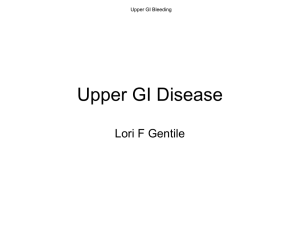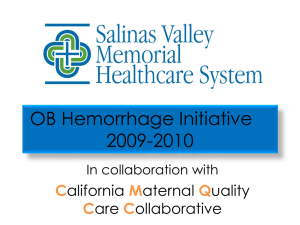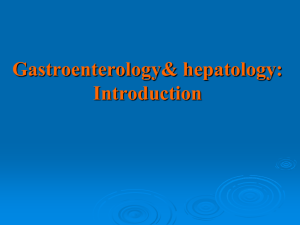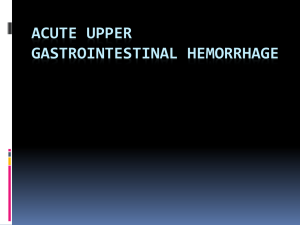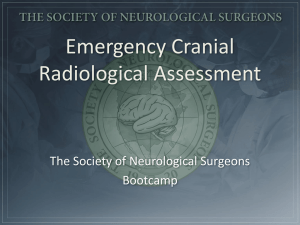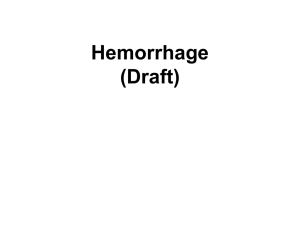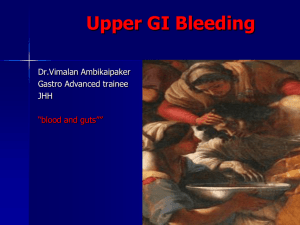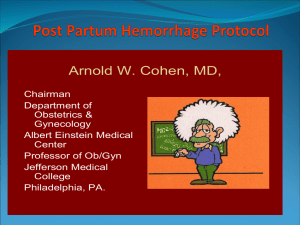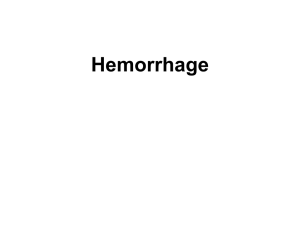Bender_ UGI - OU Medicine
advertisement
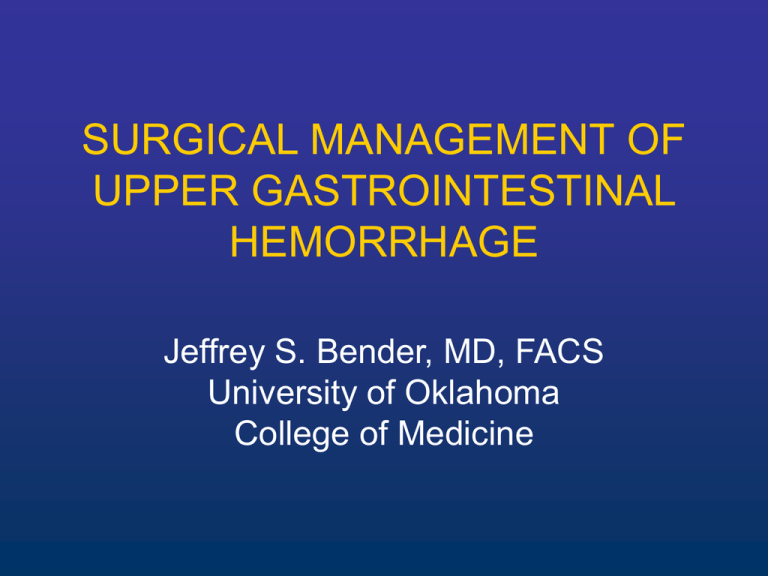
SURGICAL MANAGEMENT OF UPPER GASTROINTESTINAL HEMORRHAGE Jeffrey S. Bender, MD, FACS University of Oklahoma College of Medicine Objectives • Follow the changing patterns of the disease • Outline the current scope of the problem • Diagnostic and non-operative modalities • Future management UGI Hemorrhage • Approximately 30% decline in rate over last 15 years • 150,000 admissions per year • Over $1,000,000,000 annually • Associated with NSAID use UGI Hemorrhage • Mortality rate 8-10% • >65 now comprise over 30% • Peptic ulcer still most common cause • Surgery now plays an adjunctive role UGI Hemorrhage: 1985 • 40 y.o. man with known or suspected PUD • Often significant co-morbidities (drugs, ETOH, etc.) • Hematemesis and hypotension • NGT placed and volume resuscitated UGI Hemorrhage: 1985 • EGD reveals 1.5 cm DU with visible vessel • 6 units PRBC transfused • OR: oversewing and vagotomy and pyloroplasty • Discharged home POD#4; F/U:?; uninsured:? UGI Hemorrhage: 2005 • 48 y.o. female s/p Roux-en-Y gastric bypass with subsequent revision • One day h/o abdominal pain • CT scan: pneumoperitoneum • OR: perforated DU: Graham patch UGI Hemorrhage: 2005 • POD #2: intermittent BRBPR • Volume resuscitated • Intermittently hypotensive • Nuclear medicine: tagged RBC scan UGI Hemorrhage: 2005 • Suspected bleed from transverse colon • Bleeding continues • Arteriogram performed X 2 UGI Hemorrhage: 2005 • Occluded celiac axis • Retrograde flow via inferior pancreatico- duodenal artery • Fills hepatic, left gastric, splenic arteries • Unable to embolize 2nd branch of IPDA UGI Hemorrhage: 2005 • OR: duodenotomy with bleeding point third portion oversewn • 20 units PRBC • Fascia left open with vac sponge closure • Fascia closed POD #4 UGI Hemorrhage: 2005 • Prolonged ICU course (30 days) • Transferred to rehab center day #45 • Insurance: “pre-existing condition” UGI Hemorrhage: 1985 • Personal experience • 27 gastric resections • 17 vagotomies • 95th percentile UGI Hemorrhage: 2005 • OU experience (15 chiefs, 2002-2005) • 49 resections (3.3/resident) • 26 operations for perforation (1.7/resident) • 6 vagotomies (0.4/resident) • 2 laparoscopic resections UGI Hemorrhage: 1985: Literature • 10 articles in 5 major journals • “Management of Giant Duodenal Ulcer” • “Risks of Surgery for UGI Hemorrhage: 1972 vs. 1982” • “Improvements in the Diagnosis and Management of Aortoenteric Fistula” UGI Hemorrhage: 1985: Literature • “Changing Patterns of Gastrointestinal Bleeding” • “Recurrence After Parietal Cell Vagotomy” • “Esophageal Transection Fails…Variceal Bleeding” • “Topical Prostaglandin E2 in…UGI Hemorrhage” UGI Hemorrhage: 2000’s: Literature • Only 3 references in same 5 journals • “Rupture of Splenic Artery Pseudoaneurysms” • “Modified Sugiura Procedure” • “Effectiveness of Gastric Devascularization and Splenectomy…Gastric Varices” UGI Hemorrhage: 2005: Literature • “Celiac Axis Ligation…Unmanageable UGI Hemorrhage” • Arterial Embolization for Dieulafoy Bleeding” UGI Hemorrhage: 1980’s • Mostly gastroduodenal ulcers • Protocol: resuscitation, early endoscopy and operation • 66 patients, 1986-1990 • No deaths Bender, et al. Am Surg 1994 UGI Hemorrhage: 1990 What Changed? • Therapeutic endoscopy • Discovery of the role of h. pylori • Better acid suppression drugs • Liver transplant • Interventional radiology Helicobacter Pylori • First reported 1983 in mucosal biopsies of patients with active gastritis • Initially debated about role in ulcer disease • Abundant producer of urase • Elicits robust inflammatory response Pharmacologic Therapy • Oral antacids have no effect on bleeding • H2- receptor antagonists have had 27 RCT’s on over 2500 patients • Marginal improvement in surgery and death • Still widely used Collins, et al. NEJM, 1985 Proton Pump Inhibitors • Appear to be effective at high doses • Especially so with high risk patients • Effects clouded by use of therapeutic endoscopy Endoscopic Therapy • Widely accepted as most effective method • Not only controls ulcer bleeding but prevents rebleeding • Decreases need for surgery • Only meta analysis shows decrease in deaths Cook, et al. Gastroenterology, 1992 Thermal Therapy • Laser (Argon and Nd: YAG) • Monopolar electrocoagulation • Bipolar or mulitpolar electrocoagulation • Heater probe Injection Therapy • Epinephrine (1:10,000) • Saline • Absolute alcohol • Water • Sclerosing agents Which Endoscopic Therapy? • Injection, laser, multi- / bipolar and heater probe equivalent • Latter three most common (simplest) • Combination therapy not been shown more effective • Rebleed rates 15-20% Endoscopic Therapy - Questions • Lack of standardized definitions, especially in stigmata • Complications: rebleeding, 20%; perforation, 1% • Costs not defined • Role of repeat endoscopy: planned vs. rebleeding Future Endoscopic Therapies • Cryotherapy • Clips • Argon plasma coagulation • Sewing Adjunctive Therapies • Prokinetic agents • Octreotide • Dedicated units • ? Earlier surgery Second Look Endoscopy • Patients at high risk of rebleeding can be identified • Age, site, size, co-existent disease • Baylor Bleeding Score Endoscopic vs. Operative Treatment • 55 patients (of 61) with arterial bleeding or visible vessel > 2 mm • Repeated endoscopy in 24 hrs (32) or early operation (23) • Gastric resection in 79% • Rebleed: 48% endoscopy vs. 11% operation (p=0.002) Endoscopic vs. Operative Treatment • 22% required operation in endoscopy group • Mortality: 6% endoscopy vs. 7% operation • No subgroup or intent-to-treat analysis • Early 1990’s Imhof, et al. Langenbecks Arch Surg, 2003 “Modern” Management of UGI Hemorrhage • Resuscitation • High dose proton pump inhibitors • Early endoscopy with therapeutic intervention • Repeat endoscopy in 2 hours for high risk patients “Modern” Management of UGI Hemorrhage • Concomitant decision by surgery and gastroenterology regarding operation • Most deaths still due to repeated episodes of shock Operation for UGI Hemorrhage • Likely to become even less frequent • Therefore operative mortality will likely increase • No need to do a curative ulcer operation • Control hemorrhage only Future Directions • Further risk stratification • Define role of angiography • Earlier operation for those at higher risk
